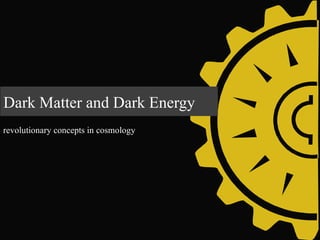Dark matter and dark energy
- 1. Dark Matter and Dark Energy revolutionary concepts in cosmology
- 2. Construction of universe 73% Dark Energy 23% Dark Matter 4% Atoms The universe is not constructed of Atoms only.
- 3. What is Dark Matter It is a type of matter that Isn't formed by atoms. Doesn't absorb or emit light. Has same gravitational properties as ordinary matter. Binds the universe together.
- 4. Construction of Dark Matter Dark matter is constructed of a supposed partical known as neutrolino. It is yet to be discovered.
- 5. Detection of Dark Matter distortion due to gravitational lensing.
- 6. Role of Dark Matter The force of gravity is inversely proportional to square of the distance between the objects.
- 7. Role of Dark Matter Dark matter binds the stars and planets within a galaxy through its gravitaional effects. It holds the galaxies in the form of constellations.
- 8. What is Dark Energy? The dark energy is non-particulate has repulsive gravity is a force that drives apart the universe
- 9. Construction of Dark Energy It is practically non-particulate. In Quantum Mechanics it is thought to be constructed of a combination of a sub-atomic partical and it's anti-particle. e.g. when neutrino and anti-neutrino combine, dark energy is formed.
- 10. Role of Dark Energy The universe is expanding. Actual continuity theory Gravitational field theory
- 11. Dark Matter vs Dark Energy Dark matter is formed of particles. It has attractive gravity. It binds the universe. Dark energy is non-particulate. It has repulsive gravity. It tears the universe.
- 12. Fate of the Universe












